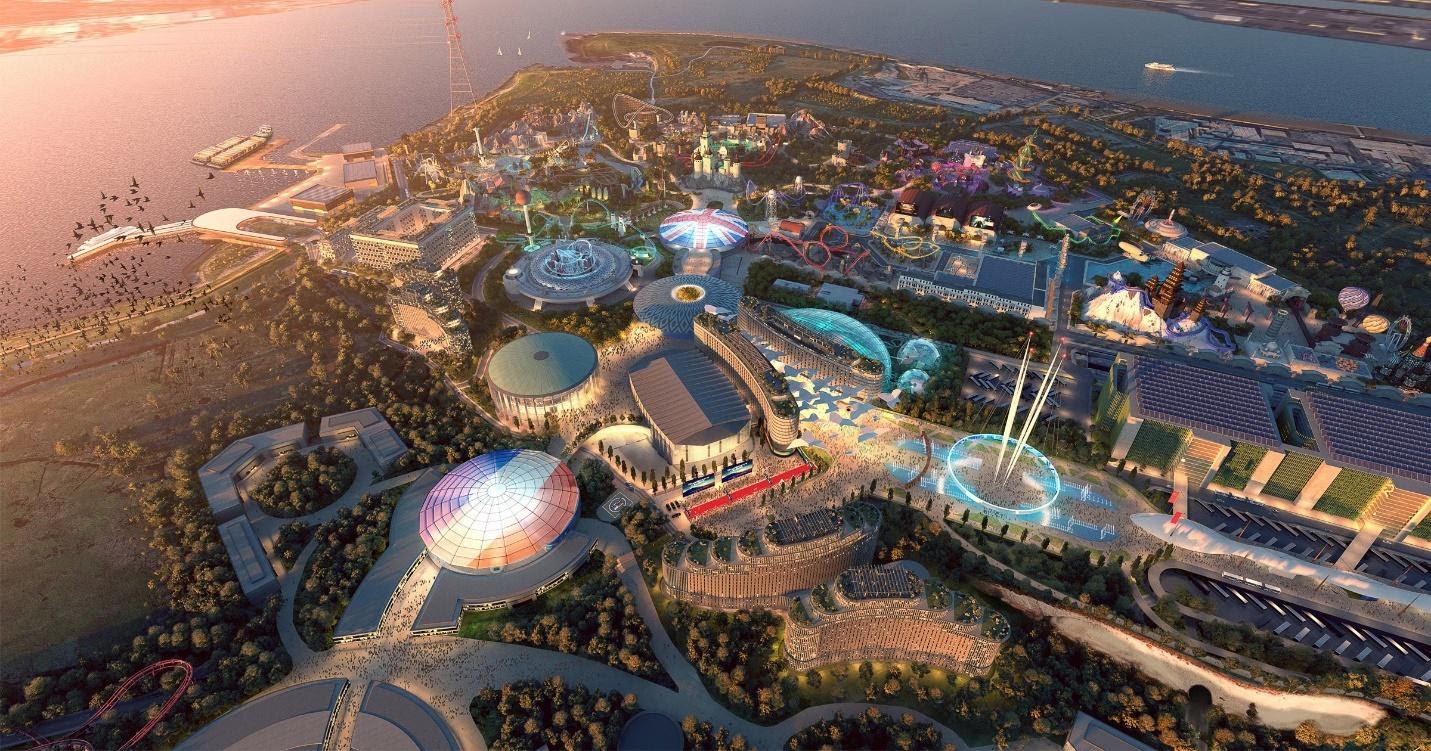Photo credit: The London Resort
The theme park which is touted to be the ‘entertainment destination of the future,’The London Resort, has submitted its planning bid.
With the project set to be built on a corner of the Swanscombe Peninsula, the gates are expected to open as early as 2024. The blueprint suggests that the park would cover almost 1,245 acres of the area – nearly 40 times more than Buckingham Palace. Alton Towers, the largest amusement park at present, would end up falling short by 300 acres once The London Resort finds its place in the map.
The Planning Inspectorate received the construction proposal on 31st December, and if given a green signal, the foundation stone can be laid by 2022. It affirms the intent of building two massive park gates, a state-of-the-art convention centre, and an e-sports facility.
Besides, 3,500 hotel rooms and two terminals for ferrying guests across the River Thames, along with an access road to the A2 is in the works. All construction materials are expected to be transported via the river route in the initial few years.
All eyes are on this project at the moment as it could become the first European theme park to be constructed from the ground up since Disneyland Paris was built in 1992.
PY Gerbeau, the man behind the success of London’s Millennium Dome, was roped in by London Resort Company Holdings in 2019 to make the project a grand affair. Until now, he reaffirmed the faith instilled by stakeholders with his words and deeds.
In Gerbeau’s first year and a half as the CEO of LRCH, he has worked on numerous iterations and reprogrammed the venture to a certain extent. Moreover, his entire team has been in constant touch with the local council members and other elected representatives, so that their views can be taken into account for the magnum opus.
As in the case of most ambitious projects, the estimated costs and the plans have undergone many revisions over time. At present, it is expected to make the investors’ wallets lighter by around £2.5 billion. However, the scale of the theme park would ensure that the principal amount is returned within the first few years of operation.
There are more numbers that help us understand why thousands of people are rooting for The London Resort’s success. Nearly £50 billion is expected in gross economic activity of the area in the first 25-year period, most of which would benefit the local communities. Besides, 48,000 lives could benefit from employment related to the park with over 6,000 people expected to be hired for construction work alone.
Among other firsts, The London Resort is planning to become the first carbon-neutral theme park in the world. That would be quite the achievement, and make the attraction one of the most sustainable human-made tourist spots in the world. Developers claim that the adjoining green areas and parkland would contribute to the environmental enhancement of the area, and thereby help in achieving a net biodiversity gain.
Now that we are into 2021, it is safe to say that The London Resort has crossed numerous hurdles to get to this stage. The concept was released to the public for the first time in 2012, and subsequently, the tag of a ‘Nationally Significant Project’ was given to the project.
Ever since, we have seen image rights contracts, artists’ impressions, and key personnel get changed. Despite so many overhauls, construction work hasn’t commenced on the site with the closest milestone being a successful public consultation and a planning proposal being sent to the government.
At a time when things already seemed to be moving at a snail’s pace, another problem emerged in the form of environmental concerns. Many local residents have objected to all kinds of construction activity citing the fact that the nearby marshes host over a thousand different kinds of endangered species.
In fact, Dartford’s councillor Laura Edie started a Facebook group named ‘Save Swanscombe Peninsula’ to fight the proposal. In her list of contentions, she raised the point that the marshes become a natural barrier when there are floods and help in absorbing CO2 from the atmosphere. Another resident, Karyn Lou, states that there would be irrepressible damage to the biodiversity oasis that thrives at the proposed site for construction.
The management offers a counter-argument that the natural features would seamlessly be integrated into the park’s designs. Further, added that a large part of the peninsula would be left untouched by them. Other assurances such as locals’ rights of way, quiet zones for the regular walkers in the area, and better access to previously undiscovered parts of the peninsula have also been made.
For now, the government has until the end of January to come up with a response regarding the adequacy of the plan. If approved, the planning Inspectorate would send a Development Consent Order (DCO), a pass that would allow them to carry out construction activities.
The Dartford council’s spokesperson, Caroline Green, made it clear that it is indeed a milestone project, and that the administration is keen on understanding how pertinent issues such as traffic management and biodiversity preservation would be addressed. In addition to this, all the small businesses in the brownfield vicinity want assurances that their livelihoods wouldn’t be impacted by the park’s operations.
While Cllr Burden, the Graveshamcouncillor, agrees that there are areas of concern, he is optimistic about finding a middle ground that is agreeable for all the stakeholders. Burden adds that the theme park bosses are willing to make amends and the DCO would present all the acceptable solutions in a detailed manner.
With nearly 64% of 120,000 local people approving the plans and 73% giving a thumbs up for the environmental enhancements, it is quite evident that not everyone is excited about roller coasters and joy rides coming to their backyard. That said, it remains to be seen what’s next in store for The London Resort.

